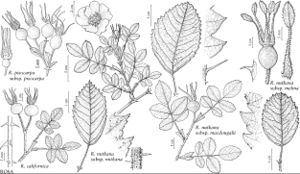Difference between revisions of "Rosa pisocarpa subsp. pisocarpa"
FNA>Volume Importer |
imported>Volume Importer |
||
| (3 intermediate revisions by 2 users not shown) | |||
| Line 1: | Line 1: | ||
{{Treatment/ID | {{Treatment/ID | ||
|accepted_name=Rosa pisocarpa subsp. pisocarpa | |accepted_name=Rosa pisocarpa subsp. pisocarpa | ||
| − | |accepted_authority= | + | |accepted_authority= |
|publications= | |publications= | ||
|basionyms= | |basionyms= | ||
| Line 7: | Line 7: | ||
|name=Rosa rivalis | |name=Rosa rivalis | ||
|authority=Eastwood | |authority=Eastwood | ||
| + | |rank=species | ||
}} | }} | ||
|hierarchy=Rosaceae;Rosaceae subfam. Rosoideae;Rosaceae tribe Roseae;Rosa;Rosa subg. Rosa;Rosa sect. Rosa;Rosa pisocarpa;Rosa pisocarpa subsp. pisocarpa | |hierarchy=Rosaceae;Rosaceae subfam. Rosoideae;Rosaceae tribe Roseae;Rosa;Rosa subg. Rosa;Rosa sect. Rosa;Rosa pisocarpa;Rosa pisocarpa subsp. pisocarpa | ||
| Line 23: | Line 24: | ||
|distribution=B.C.;Calif.;Oreg.;Wash. | |distribution=B.C.;Calif.;Oreg.;Wash. | ||
|discussion=<p>Subspecies pisocarpa encompasses traditional circumscriptions of <i>Rosa pisocarpa</i>. It occurs in coastal regions from southwestern British Columbia to northern California, west of and within the Cascade Mountains. Stems tend to have paired erect prickles, stipitate-glandular sepals with elongate tips, and clusters of pea-shaped hips. Limited populations intermediate with <i>R. woodsii </i>subsp.<i> ultramontana</i> occur in Cascade Mountain passes along the Fraser River (British Columbia), the Columbia River (Oregon and Washington), and the Klamath River (southern Oregon). Reports of <i>R. pisocarpa</i> from farther east (for example, R. J. Davis 1952) were based on <i>R. woodsii</i> or other species.</p><!-- | |discussion=<p>Subspecies pisocarpa encompasses traditional circumscriptions of <i>Rosa pisocarpa</i>. It occurs in coastal regions from southwestern British Columbia to northern California, west of and within the Cascade Mountains. Stems tend to have paired erect prickles, stipitate-glandular sepals with elongate tips, and clusters of pea-shaped hips. Limited populations intermediate with <i>R. woodsii </i>subsp.<i> ultramontana</i> occur in Cascade Mountain passes along the Fraser River (British Columbia), the Columbia River (Oregon and Washington), and the Klamath River (southern Oregon). Reports of <i>R. pisocarpa</i> from farther east (for example, R. J. Davis 1952) were based on <i>R. woodsii</i> or other species.</p><!-- | ||
| − | --><p>The Snohomish and Squaxin of Puget Sound, Washington, used < | + | --><p>The Snohomish and Squaxin of Puget Sound, Washington, used <i></i>subsp.<i> pisocarpa</i> root decoctions to treat sore throats, and bark infusions for after child-birth, respectively (D. E. Moerman 1998). Southeastern Vancouver Island Saanich have used young shoots for food in the spring; ripe hips were eaten raw in the fall. They also boiled branches to make a decoction, which was used to flush the eyes of those not able to see well; this preparation served to treat any eye problem, including cataracts (N. J. Turner, pers. comm.).</p> |
|tables= | |tables= | ||
|references= | |references= | ||
| Line 32: | Line 33: | ||
-->{{#Taxon: | -->{{#Taxon: | ||
name=Rosa pisocarpa subsp. pisocarpa | name=Rosa pisocarpa subsp. pisocarpa | ||
| − | + | |authority= | |
| − | |authority= | ||
|rank=subspecies | |rank=subspecies | ||
|parent rank=species | |parent rank=species | ||
| Line 47: | Line 47: | ||
|publication year= | |publication year= | ||
|special status= | |special status= | ||
| − | |source xml=https:// | + | |source xml=https://bitbucket.org/aafc-mbb/fna-data-curation/src/2e0870ddd59836b60bcf96646a41e87ea5a5943a/coarse_grained_fna_xml/V9/V9_162.xml |
|subfamily=Rosaceae subfam. Rosoideae | |subfamily=Rosaceae subfam. Rosoideae | ||
|tribe=Rosaceae tribe Roseae | |tribe=Rosaceae tribe Roseae | ||
Latest revision as of 22:54, 5 November 2020
Plants often forming thickets. Stems loosely to densely clustered, 10–25 dm; infrastipular prickles primarily (1–)2, 2–10 mm. Leaves 5–10 cm; leaflets 5–7(–9), most commonly 7, terminal blade 15–35 mm. Inflorescences (1–)3–12-flowered. Flowers: sepal tip to 10 mm, abaxial surfaces usually stipitate-glandular; carpels 22–35. Hips usually globose, rarely subglobose, 7–10 mm diam., abruptly narrowed to neck 1.5–3 mm diam. Achenes 25–35. 2n = 14.
Phenology: Flowering Jun–Aug.
Habitat: Coasts, stream banks, riparian areas, open and low places, sedge meadows, swamps, roadside hedges, thickets, montane oak belts
Elevation: 30–2100 m
Distribution

B.C., Calif., Oreg., Wash.
Discussion
Subspecies pisocarpa encompasses traditional circumscriptions of Rosa pisocarpa. It occurs in coastal regions from southwestern British Columbia to northern California, west of and within the Cascade Mountains. Stems tend to have paired erect prickles, stipitate-glandular sepals with elongate tips, and clusters of pea-shaped hips. Limited populations intermediate with R. woodsii subsp. ultramontana occur in Cascade Mountain passes along the Fraser River (British Columbia), the Columbia River (Oregon and Washington), and the Klamath River (southern Oregon). Reports of R. pisocarpa from farther east (for example, R. J. Davis 1952) were based on R. woodsii or other species.
The Snohomish and Squaxin of Puget Sound, Washington, used subsp. pisocarpa root decoctions to treat sore throats, and bark infusions for after child-birth, respectively (D. E. Moerman 1998). Southeastern Vancouver Island Saanich have used young shoots for food in the spring; ripe hips were eaten raw in the fall. They also boiled branches to make a decoction, which was used to flush the eyes of those not able to see well; this preparation served to treat any eye problem, including cataracts (N. J. Turner, pers. comm.).
Selected References
None.
